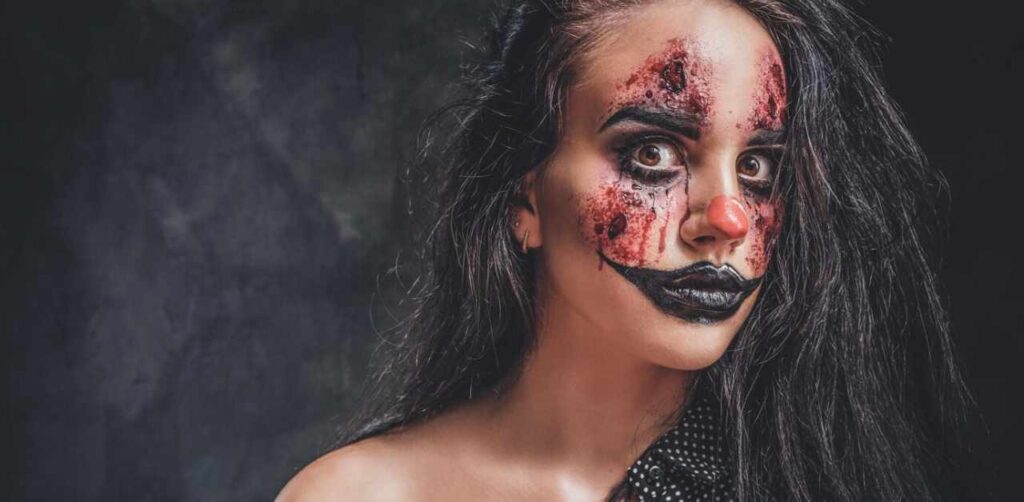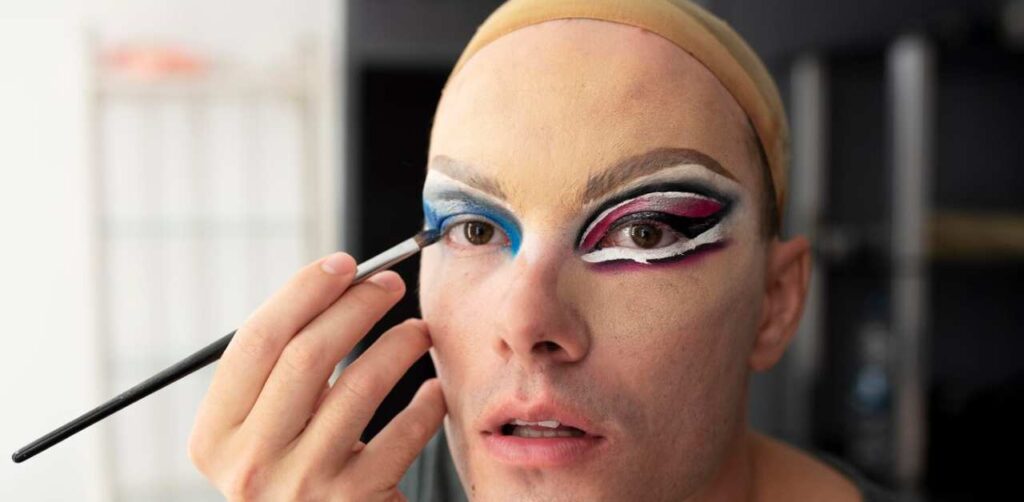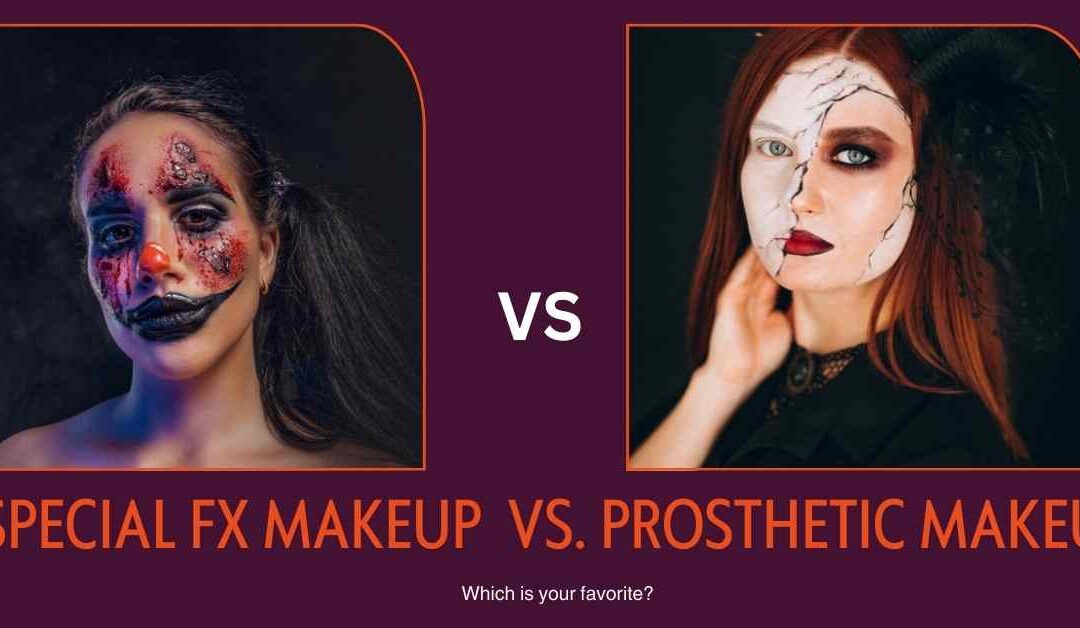Are you a makeup artist, beauty student, or movie buff wondering what really sets Special FX apart from Prosthetic Makeup? You’re not alone! In today’s entertainment world—whether it’s blockbuster films, gripping web series, or even cosplay and stage shows—the demand for high-level transformation is growing fast. But when it comes to Special FX vs. Prosthetic Makeup, many still confuse the two.
While both techniques help bring imagination to life, they serve different purposes. From dramatic injury effects to full-blown creature design, SFX makeup and prosthetic effects play a vital role in visual storytelling. Understanding these two advanced makeup techniques can help you choose the right path for your career in film and TV makeup, theatrical productions, or even the world of fantasy and horror.
Let’s break down the real differences, their uses, and why learning these skills in 2025 is a must for any serious makeup professional.
What is Special FX Makeup?

Prosthetic Makeup
Special FX (or SFX) makeup is a transformative makeup technique used to create extraordinary visual effects on the skin and body. It goes beyond traditional makeup by using tools like latex, silicone, wax, and paints to simulate wounds, scars, burns, aging, creatures, or fantasy characters.
Often seen in films, TV shows, theater, and even haunted houses, Special FX makeup plays a critical role in storytelling by visually altering an actor’s appearance to suit a specific character or scene. It demands a strong understanding of anatomy, color theory, and materials to achieve realistic or supernatural effects that wow audiences.
Example: Freddy Krueger’s iconic look in A Nightmare on Elm Street was a prosthetic masterpiece. Created by David B. Miller and later refined by Kevin Yagher, Freddy’s burned skin was crafted through prosthetic sculpting and application.
This process requires lifecasting (taking a mold of the actor’s face or body), sculpting a new look, and creating the prosthetics for application.
What is Prosthetic Makeup?

Special FX Makeup
Prosthetic makeup is a specialized branch of Special FX makeup that involves creating and applying custom-made appliances—called prosthetics—to dramatically alter an actor’s appearance. These prosthetics are sculpted using materials like foam latex, silicone, or gelatin and are designed to blend seamlessly with the skin to create hyper-realistic effects. Whether it’s adding a new nose, transforming someone into an alien, or aging a young actor by decades, prosthetic makeup brings imagination to life through advanced artistry.
This technique is commonly used in high-end films, fantasy series, and even medical simulation training. The process often includes lifecasting (creating a 3D mold of the actor’s face or body), sculpting the new look, and then molding and painting the final prosthetic for realistic detail. It requires precision, patience, and a deep understanding of both art and science to make characters look believable under high-definition cameras.
Special FX vs. Prosthetic Makeup: Key Differences
| Aspect | Special FX (SFX) Makeup | Prosthetic Makeup |
| Definition | A broad category of makeup used to create visual effects on skin/body | A specialized technique involving sculpted 3D appliances |
| Focus | Includes cuts, bruises, burns, fantasy looks, aging, etc. | Focuses on building and applying custom prosthetic pieces |
| Techniques Used | Painting, latex, wax, silicone, airbrushing | Lifecasting, sculpting, molding, casting, blending prosthetics |
| Materials Used | Latex, gelatin, silicone, wax, paints | Foam latex, silicone, gelatin, prosthetic adhesives |
| Complexity | Varies from basic to advanced | Usually more complex and time-consuming |
| Application | Directly onto the skin or over small appliances | Uses pre-made 3D pieces blended into the actor’s face/body |
| Used In | Films, TV shows, theater, photo shoots, haunted houses | High-end film/TV roles, character transformations, fantasy/sci-fi genres |
| Example | Fake wounds, aging makeup, monster face painting | Freddy Krueger’s burned face, alien creatures, transformation masks |
Why These Skills Matter in 2024
Why Special FX Makeup Skills Matter.
With the surge in high-definition streaming content, immersive theater, gaming, and live-action roleplay, Special FX makeup artists are more in demand than ever. Production houses are seeking artists who can craft realistic wounds, creatures, supernatural beings, and dramatic transformations without relying entirely on CGI.
Mastering Special FX makeup equips professionals to work on global-level projects across film, TV, music videos, theme parks, and even experiential events. It’s not just makeup—it’s visual storytelling at its most creative and dynamic.
Prosthetic Makeup Skills Matter in 2025
As audiences expect more realism and precision, prosthetic makeup has become a vital part of modern filmmaking, advertising, and media. From biopics that require aging transformations to fantasy characters with detailed facial structures, prosthetic makeup brings characters to life in ways that traditional makeup cannot.
In 2025, prosthetic work is especially crucial in international productions, character design, and projects requiring intense transformation with a natural look. Skilled prosthetic artists are key players behind unforgettable characters and cinematic magic.
Common Uses of Prosthetic Makeup
Prosthetic makeup is a versatile tool used in various industries. Here’s where it’s most commonly applied:
- Character Transformation: Prosthetic makeup is essential for creating fantasy characters or creatures in films, TV shows, or theater. It helps actors become unrecognizable with the addition of features like alien skin, monster teeth, or animal faces.
- Simulating Injuries or Wounds: It’s used in movies and television to create realistic injury effects, such as cuts, burns, or scars. Prosthetics can make fake injuries look incredibly lifelike for horror films, medical simulations, or war scenes.
- Aging Effects: Prosthetics can make an actor look significantly older or younger than they are. This is often seen in historical films, biopics, or projects that require drastic age transformations.
- Fantasy & Sci-Fi Characters: Prosthetics are used to create non-human features for fantasy or science fiction genres. These could include elf ears, robot faces, or mythical creatures like werewolves, making these fantastical elements appear realistic.
- Theater & Stage Performances: In live performances, prosthetic makeup helps actors enhance their portrayal of larger-than-life characters. From exaggerated facial features to elaborate body prosthetics, it adds visual impact on stage.
- Haunted Houses & Horror Attractions: In theme parks or haunted houses, prosthetics bring creepy characters to life. These makeup effects are designed to scare or shock, with the use of grotesque, unsettling designs like zombies or ghosts.
Prosthetic Makeup Process
The process of creating prosthetic makeup involves several detailed steps to ensure a flawless, realistic result. Here’s a simple breakdown of how it works:
- Lifecasting (Making a Mold): First, the artist makes a mold of the actor’s face or body part using materials like silicone or plaster. This mold acts as the base for creating the prosthetic piece and helps ensure a perfect fit on the actor’s body.
- Sculpting: The next step involves creating the desired shape or feature. Sculpting is done using clay or other moldable materials, where the artist shapes the prosthetic (like a wound, extra ear, or monster mask) to match the design.
- Creating the Mold: Once the sculpt is complete, the artist creates a negative mold (a cast) of the sculpted design. This is usually done using rubber or fiberglass. The mold will hold the shape and allow the prosthetic to be reproduced multiple times.
- Casting the Prosthetic: Materials like foam latex, silicone, or gelatin are poured into the mold to create the prosthetic. The casting material is chosen depending on the need for flexibility, durability, or realism. This step results in the actual prosthetic piece that will be applied to the actor.
- Applying the Prosthetic: The prosthetic is carefully attached to the actor’s skin using specialized adhesives. The edges of the prosthetic are blended seamlessly with the skin to avoid visible seams. This ensures it looks natural and stays in place during filming or performance.
- Painting & Detailing: Once applied, the prosthetic is painted to match the skin tone and enhance its realism. Details like veins, bruises, or textures are added to make the piece look as lifelike as possible. In cases of injuries, additional effects like blood or gloss can be applied.
- Final Touches: In some cases, hair is added to the prosthetic, like eyebrows or scars that require hair. Gloss or other special effects may also be added to make the prosthetic more dynamic on camera, depending on the character or scene.
This process can take hours or even days, but the result is a stunning, life-like transformation that allows actors to embody any character, from a terrifying monster to a beautiful fairy, all thanks to prosthetic makeup.
Pro Tip from Riya Vashist
As a Hollywood-certified Celebrity Makeup Artist with over 20 years of experience, Riya Vashist shares a valuable tip for anyone venturing into the world of Special FX and prosthetic makeup:
“Mastering the basics of makeup artistry is essential before diving into special effects and prosthetics. Start by perfecting your foundational skills—understanding skin tones, textures, and shading techniques. This knowledge is crucial when creating lifelike prosthetics or fantasy characters. For prosthetics, patience is key. Whether it’s sculpting or applying the prosthetic, take your time to ensure each step is flawless. The more attention you give to detail, the more realistic and seamless the final result will be.”
By focusing on the fundamentals and being patient, you’ll develop a solid foundation that will help you excel in advanced makeup techniques like SFX and prosthetics, no matter the challenge. Keep learning, experimenting, and refining your skills!
Final Thoughts: Which One Is Right for You?
Choosing between special-effects makeup and Prosthetic Makeup depends largely on your goals, the type of work you want to pursue, and the skills you wish to master. Both are essential techniques in the makeup industry, but they cater to different needs:
- Special FX Makeup is ideal for creating dramatic, temporary effects. If you’re interested in working on films, theater productions, or Halloween events where you need to create injuries, fantasy characters, or supernatural transformations, SFX is a great option. It offers more flexibility and is quicker to apply, making it suitable for projects with short timelines.
- Prosthetic Makeup, on the other hand, is perfect for high-end, long-lasting transformations. If you’re aiming to work in major motion pictures or television, where character realism is crucial (think of superhero movies or historical period dramas), prosthetics will be your go-to. While it takes more time and expertise to apply, it provides a higher level of detail and longevity, often becoming an integral part of a character’s identity.
For those looking to become industry leaders like Riya Vashist, mastering both techniques could be the ultimate path. By blending the creativity and versatility of SFX with the realism and artistry of prosthetics, you can elevate your skills and offer a broad range of services to clients.
Ultimately, the choice is yours. Each technique has its own set of exciting challenges and opportunities. Whichever path you choose, the most important thing is to keep learning, practicing, and pushing the boundaries of your artistry.
If you’re looking to deepen your skills, whether it’s in SFX or prosthetics, consider exploring professional makeup courses at THE RIYA VASHIST – An International School of Makeup Art. With guidance from industry experts, you can elevate your techniques and get a step closer to working with top celebrities and film productions!
Also, Read Article
How to Do Bridal Makeup: Step-by-Step Tutorial & Inspiration
Airbrush vs HD Makeup: Pros, Cons, and How to Choose the Right One
How to Use a Charcoal Peel-Off Mask: A Step-by-Step Skincare Guide
How to Use Coffee Face Pack for Tan Removal: DIY Recipe & Skin Benefits
